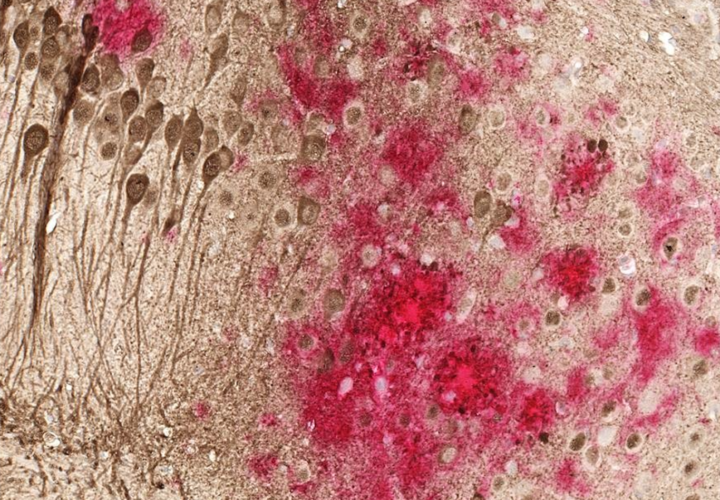Learn more about what may cause brain plaque and why scientists believe plaques and tangles in the brain lead to Alzheimer's and other forms of dementia.
Researchers have been focusing on how brain plaque contributes to Alzheimer’s disease since Dr. Alois Alzheimer noticed strange clumps in a patient’s brain after her death. When toxic proteins like beta-amyloid and tau accumulate in the brain, they form plaques and tangles. Some researchers suggest these plaques and tangles resemble Swedish meatballs when examined under a microscope. Scientists are still looking into why some people have more plaques and tangles in their brains than others. However, they believe genetics and lifestyle choices play a role.
Could Alzheimer’s Drugs Tackle Brain Plaque?
Many Alzheimer’s drugs have been designed to reduce brain plaque by targeting beta-amyloid and tau. But recent drug failures have caused some scientists to question whether it’s worth it to spend billions of dollars on drugs that have had little impact.
Even so, most researchers are confident that beta-amyloid or tau plaques and tangles cause cell death, leading to Alzheimer’s. They believe pharmaceutical companies just need to test these drugs on participants before too much plaque builds up.
Do Genetics Cause Excess Brain Plaque?
Scientists found three genetic mutations that greatly increase your early-onset Alzheimer’s risk. The APP, PSEN1 and PSEN2 gene mutations cause the brain to create too much beta-amyloid and tau plaques and tangles. The TREM2 mutation also prevents the brain from eliminating harmful plaques and tangles. In addition, the ApoE4 gene increases Alzheimer’s risk by up to 12 times. The gene has also been shown to impact how tau and beta-amyloid affect the brain. Still, researchers emphasize that a family history of Alzheimer’s doesn’t necessarily mean that you will develop the disease.
What Lifestyle Risk Factors Lead to Plaques and Tangles?
Alcohol Consumption: In a recent study on mice, researchers found that too much alcohol does not create toxic proteins in the brain. Instead, it limits the microglia, known as the ‘janitors of our brain,’ from doing their job effectively. Microglia are built to get rid of the junk that increases brain plaques and tangles. However, the team acknowledged that they gave the mice far more alcohol than an average human would drink in one hour and scientists are still looking into exactly how alcohol could increase Alzheimer’s risk.
Smoking: Other studies showed that smoking could exacerbate Alzheimer’s symptoms in people with too many plaques and tangles. In one experiment, researchers gave mice with brain plaques and tangles nicotine and noticed their Alzheimer’s symptoms became worse than the mice who were not given the drug. For example, they had more issues getting through a maze.
Cholesterol and Blood Pressure: Similarly, having high cholesterol and blood pressure is associated with diabetes and Alzheimer’s. Some researchers even call Alzheimer’s “Type 3 Diabetes.” Studies indicate that it is more common for people with higher blood pressure to have additional brain plaques and tangles. Scientists think making lifestyle changes could help those who are genetically predisposed to Alzheimer’s reduce these plaques and tangles.

How a Good Night’s Sleep Could Reduce Plaques and Tangles
Many caregivers report that Alzheimer’s causes disrupted sleep and sundowning. Sundowning is a common Alzheimer’s symptom that leads to increased confusion in the late afternoon or early evening. But researchers have also discovered that frequent nights spent tossing and turning may also cause Alzheimer’s.
In a recent study, scientists found that those with sleep apnea or who snore loudly were more likely to have increased amounts of tau in their brains. Other studies have found that participants with fragmented sleep patterns—taking short cat-naps throughout the day—had more beta-amyloid plaques than participants who got a consistent eight hours of sleep each night. A 2017 analysis found that poor sleepers appeared to have about a 68 percent higher risk of cognitive issues including Alzheimer’s than those who were well-rested. In other words, getting some shut-eye will not only give your brain a boost, but could also prevent your brain from developing additional plaques and tangles.
The Connection Between Exercise and Brain Plaque Reduction
Scientists reported that when we exercise, our brains produce a protein known as Irisin, which benefits our thinking abilities and may even lead to neural growth in the hippocampus. In another recent study, scientists found that aerobic exercise could make your brain act up to 20 years younger. The benefits of exercise don’t end there: Researchers think that in addition to sleep, exercising could also decrease Alzheimer’s-related plaques and tangles in the brain.
Last year, scientists pushed mice genetically engineered to have Alzheimer’s to exercise for up to three hours at a time by giving them running wheels. They gave the other Alzheimer’s mice gene therapy and drugs meant to help them form new nerve cells. The researchers learned that the mice who exercised did better on cognitive tests than the other group and had smaller levels of beta-amyloid plaques in their brains. Neuroscientist Wendy Suzuki said that exercise can also “re-sculpt” your brain and lower dementia risk by up to 90 percent.
Nutrition and Alzheimer’s Prevention
Studies show that eating a Mediterranean-style diet could also reduce dementia risk. MIND diet creator Martha Clare Morris, Sc.D., found that consuming a diet of mostly veggies, grains, fish, poultry and even some wine decreased participants’ Alzheimer’s risk by up to 53 percent. UCSF biochemist and nutrition researcher Ed Blonz, Ph.D., hypothesize that unhealthy glucose levels could also lead to Alzheimer’s pathogens. He said that too much glucose and limited amounts of glucose in the body result in harmful processes in the brain, including a build-up of beta-amyloid and tau plaques and tangles, as well as inflammation that eventually turns into Alzheimer’s symptoms. To keep glucose levels stable, lower your intake of sugar and refined carbohydrates. Stick with whole-grain foods that are high in fiber.
You may not be able to prevent a genetic link to Alzheimer’s and its effect on brain plaque. But the research shows that lifestyle changes could help you cut your dementia risk by halting some of the harmful processes in the brain that eventually present themselves as memory issues and other Alzheimer’s symptoms.




